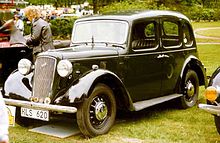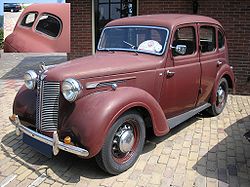Austin 10
| Austin 10 | |
|---|---|
| Production period: | 1911-1915 1932-1947 |
| Class : | Middle class , lower middle class |
| Body versions : | Touring car , roadster , sedan , station wagon , convertible , vans , flatbed |
| Successor: | Austin 12/14 , Austin A40 , Austin K8 |
Austin 10 was the name of several lower middle class cars made by the Austin Motor Company .
Austin 10 hp (1911-1912)
| 10 hp (1911-1912) | |
|---|---|
| Production period: | 1911-1912 |
| Body versions : | Touring car |
| Engines: |
Otto engine : 1.15 liters |
| Length: | 3302 mm |
| Width: | 1410 mm |
| Height: | |
| Wheelbase : | 2438 mm |
| Empty weight : | Chassis: 533 kg |
The first Austin 10 (hp) came out in 1911 as a mid-range touring car. It had a front-mounted, side-controlled four-cylinder in-line engine with a displacement of 1,145 cm³. The wheels were suspended from three-quarter elliptical leaf springs. After the first Austin 7 was discontinued , the 10 hp was the smallest model in the Austin range.
Austin 10 hp (1913-1915)
| 10 hp (1913-1915) | |
|---|---|
|
Image does not exist |
|
| Production period: | 1913-1915 |
| Body versions : | Touring car |
| Engines: |
Gasoline engine : 1.6 liters |
| Length: | 3734 mm |
| Width: | |
| Height: | |
| Wheelbase : | 2515-2819 mm |
| Empty weight : | |
In 1913 the Austin 10 (hp) appeared with a 3 ″ (76 mm) enlarged wheelbase and an engine with cylinders bored out to 76 mm. This resulted in a displacement of 1,615 cm³ with the same stroke. There was also a touring car with a wheelbase that was 1 foot (304 mm) longer. In 1916 the 12/14 hp model replaced the 10 hp.
Austin 10/4 and Austin 10 (1932–1938)
| 10/4 (1932-1936) 10 (1937-1938) |
|
|---|---|
|
Austin 10/4 Sedan (1933) |
|
| Production period: | 1932-1938 |
| Body versions : | Touring car , roadster , sedan , station wagon , convertible |
| Engines: |
Petrol engines : 1.1 liters (15.5–22 kW) |
| Length: | 3353 mm |
| Width: | 1365 mm |
| Height: | |
| Wheelbase : | 2363 mm |
| Empty weight : | 787 kg |
The Austin 10/4 was Austin's bestseller in the 1930s and was manufactured until 1938. In size it was between the Austin 7 and the Austin 12 , which was released in a new form in 1932.
The construction of the vehicle is conservative; it has a pressed steel body that was built on an X-beam chassis. The chassis is lowered 70 mm between the axles. This enables the vehicle to be kept low overall. The side-controlled 4-cylinder in-line engine with 1,125 cm³ and an output of 21 bhp (15.5 kW) drives the rear wheels via a 4-speed gearbox and an open cardan shaft. All 4 wheels are suspended from semi-elliptical springs and the brakes are operated via pull cables. The electrical system was designed with 6 V. The four-door sedan was only produced in two versions in the first year: The basic model cost GBP 155 and achieved 88 km / h with a consumption of approx. 8.25 l / 100 km. The “Sunshine” or “De Luxe” model with a roll-up roof and leather interior cost GBP 168.
In 1933 the range was supplemented with an open two-seater (“Open Road”), a convertible (“Colwyn”) and a station wagon. A sports model, the "Ripley" with an output of 30 bhp (22 kW) and a top speed of 104 km / h, expanded the selection in 1934 . This year's technical improvements included a stronger chassis, a synchronized gearbox and a 12V electrical system.
The first styling change took place at the end of 1934: the nickel-plated radiator grille was replaced by one in the same color as the car, which was also inclined slightly backwards. The synchronization was also introduced for 2nd gear and the cars were equipped with indicators as standard. The limousine was nicknamed "Lichfield" and had an attached trunk that also accommodates the spare wheel.
There was a new body shape in 1936 with the 6-window model “Sherbourne” (3 windows on each side, one behind the rear door), but the big change came in 1937 with the almost streamlined sedan “Cambridge” and the convertible “Conway”. Other changes included the Girling bar brakes , 16 steel wheels instead of the 19 spoke wheels, and more space for the occupants by moving the engine forward by 100 mm. The top speed increased to 96 km / h. These changes did not come to the open car (without "Ripley") only from 1938. In that year all vehicles got an aluminum cylinder head.
As in previous editions, numerous chassis were equipped with bodies from independent manufacturers; many of them were made by Gordon & Co. in Birmingham .
Austin 10 / Austin 10 Van / Pick-up (1939–1947)
| 10 (1939-1947) | |
|---|---|
|
Austin 10 Sedan (1946) |
|
| Production period: | 1939-1947 |
| Body versions : | Limousine , station wagon , convertible , panel van , flatbed truck |
| Engines: |
Petrol engines : 1.1–1.2 liters (24 kW) |
| Length: | 4013 mm |
| Width: | 1486 mm |
| Height: | |
| Wheelbase : | 2369 mm |
| Empty weight : | 902 kg |
A brand new Austin 10 came out in 1939. The body now also encompassed the floor, creating a semi-self-supporting structure. The car was designed by the Argentine Ricardo "Dick" Burzi, who came to Austin from Lancia in 1929 . The bonnet was hinged at the back instead of in the middle, the radiator grille was rounder and there was no longer a convertible. Despite the outbreak of World War II , production of the Austin 10 continued in large numbers. There was no longer a tourer, but a pick-up and a box van (van). A total of 53,000 sedans, pick-ups, panel vans and station wagons were produced. The latter were unofficially called "Tillies".
After the peace treaty in 1945, war production was immediately switched to civilian cars, but almost all of them were exported due to the post-war financial crisis. The first Austin arrived in the US in July 1945. The station wagon also reappeared with an engine slightly enlarged to 1,237 cm³.
The Austin 10 remained in production until October 1947 and was replaced by the Austin A40 Dorset and Austin A40 and Austin K8 (van, pick-up).
literature
- David Culshaw, Peter Horrobin: The Complete Catalog of British Cars 1895-1975. Veloce Publishing PLC, Dorchester 1997, ISBN 1-874105-93-6 .
- Jonathan Wood: Austin's Top Ten. The Automobile, May 1999.
- The Austin 10 Drivers club ( Memento from August 29, 2009 in the Internet Archive )
Web links
Individual evidence
- ↑ Nick Walker: A – Z of British Coachbuilders 1919–1960 . Shebbear 2007 (Herridge & Sons Ltd.) ISBN 978-0-9549981-6-5 , p. 115.




